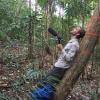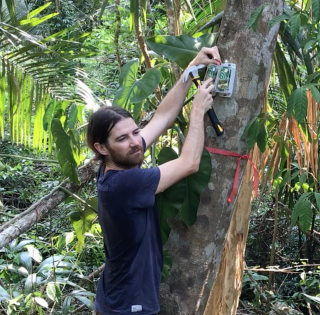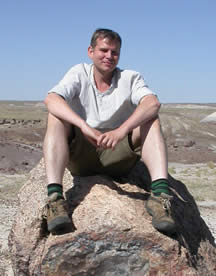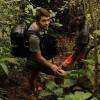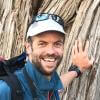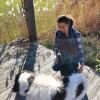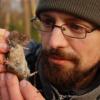Acoustic sensors enable efficient and non-invasive monitoring of a wide range of species, including many that are difficult to monitor in other ways. Although they were initially limited in application scope largely due to cost and hardware constraints, the development of low-cost, open-source models like the Audiomoth in recent years has increased access immensely and opened up new avenues of research. For example, some teams are using them to identify illicit human activities through the detection of associated sounds, like gunshots, vehicles, or chainsaws (e.g. OpenEars).
With this relatively novel dimension of wildlife monitoring rapidly advancing in both marine and terrestrial systems, it is crucial that we identify and share information about the utility and constraints of these sensors to inform efforts. A recent study identified advancements in hardware and machine learning applications, as well as early development of acoustic biodiversity indicators, as factors facilitating progress in the field. In terms of limitations, the authors highlight insufficient reference sound libraries, a lack of open-source audio processing tools, and a need for standardization of survey and analysis protocols. They also stress the importance of collaboration in moving forward, which is precisely what this group will aim to facilitate.
If you're new to acoustic monitoring and want to get up to speed on the basics, check out these beginner's resources and conversations from across the WILDLABS platform:
Three Resources for Beginners:
- Listening to Nature: The Emerging Field of Bioacoustics, Adam Welz
- Ecoacoustics and Biodiversity Monitoring, RSEC Journal
- Monitoring Ecosystems through Sound: The Present and Future of Passive Acoustics, Ella Browning and Rory Gibb
Three Forum Threads for Beginners:
- AudioMoth user guide | Tessa Rhinehart
- Audiomoth and Natterjack Monitoring (UK) | Stuart Newson
- Help with analysing bat recordings from Audiomoth | Carlos Abrahams
Three Tutorials for Beginners:
- "How do I perform automated recordings of bird assemblages?" | Carlos Abrahams, Tech Tutors
- "How do I scale up acoustic surveys with Audiomoths and automated processing?" | Tessa Rhinehart, Tech Tutors
- Acoustic Monitoring | David Watson, Ruby Lee, Andy Hill, and Dimitri Ponirakis, Virtual Meetups
Want to know more about acoustic monitoring and learn from experts in the WILDLABS community? Jump into the discussion in our Acoustic Monitoring group!
Header image: Carly Batist
PhD researcher at the University of East Anglia with the working title - "From landscape to soundscape: what drives spatial variation in natural soundscape characteristics?"
- 0 Resources
- 0 Discussions
- 2 Groups
Newcastle University
Senior Lecturer in Biological Modelling. Interests in AI, spatial data, invertebrate ecology, species mapping

- 0 Resources
- 8 Discussions
- 4 Groups
- @pmarchetto
- | he/him
University of Minnesota
http://about.me/pete.marchetto
- 1 Resources
- 0 Discussions
- 3 Groups
National Geographic Society
Experience utilizing technology to inspire, educate, and create solutions to some of our biggest challenges. Currently, head of the National Geographic Society Exploration Technology Lab, overseeing the development and deployment of research and storytelling technologies.
- 0 Resources
- 0 Discussions
- 16 Groups
University of Florida (UF)
PhD student - acoustic monitoring in Amazon flooded forests.



- 0 Resources
- 17 Discussions
- 1 Groups
I'm a wildlife ecologist with interests in a range of technology.


- 0 Resources
- 22 Discussions
- 5 Groups
- @ana-alcantara
- | She/her
Postgraduate Biology student interested in bioacoustics, conservation biology and biodiversity
- 0 Resources
- 1 Discussions
- 10 Groups
- @AthenaRycyk
- | she/her
- 0 Resources
- 0 Discussions
- 8 Groups
- @SamuelHertz
- | He/Him/His
I'm a PhD researcher at Royal Holloway University of London (Centre for GeoHumanities) researching modalities of sound-sensing technologies across climate and conservation sciences. Interested in ethics and histories of acoustic monitoring as well as new visualization methods.
- 0 Resources
- 3 Discussions
- 10 Groups
Nature lover
- 0 Resources
- 0 Discussions
- 5 Groups
- @dhanushshetty
- | he/him
Centre for Wildlife Studies
Doctoral fellow at Centre for Wildlife Studies
- 0 Resources
- 0 Discussions
- 1 Groups
- @maddy
- | Dr
Iam a Doctorate in molecular bology by profession & associated with a tech startup, focued on IoT/sensor based automation solutions. But I spend half of my time to document and conserve local & wildlife arond us and trying to explore our technology in conservation.Love to join
- 0 Resources
- 0 Discussions
- 5 Groups
This latest chapter in the Conservation Technology Series from WWF-UK looks at the opportunities, challenges and state-of-the-art of satellite remote sensing for conservation applications. This issue reviews available...
23 April 2018
Hundreds of people joined our #Tech4Wildlife photo challenge this year, showcasing all the incredible ways tech is being used to support wildlife conservation. We've seen proximity loggers on Tasmanian Devils in...
3 March 2018
Our panel of international experts has been hard at work reviewing the 47 proposals we recieved for innovative technological tools to address human wildlife conflict. The panelists have systematically been assessing the...
20 October 2017
The inherent complexity of not only deploying technologies in the field but also doing so in a scientifically rigorous manner can prove a substantial barrier for the effective use of conservation technologies, and clear...
11 October 2017
Its been a busy couple of months for the Open Acoustic Devices team. They've just returned back from Belize where they have been trialling the new AudioMoth design for gunshot detection. Find out what they've been up to...
27 June 2017
Are you ready for this year's #Tech4Wildlife Photo Challenge? In anticipation, we're counting down our ten favourite entries from last year. Do you think you can top these?
1 March 2017
The Conservation Leadership Programme (CLP) is a training and capacity building programme that targets individuals from developing countries who are early in their conservation career and demonstrate leadership...
21 November 2016
Do you work on conserving Neotropical migratory birds? Do you need funding? Why not apply for a grant from the U.S. Fish and Wildlife Service through the Neotropical Migratory Bird Conservation Act's grant program? The...
8 November 2016
Caves don't tend to be well-liked ecosystems, being extremely dark, often quite cramped, and slippery. And the creepy-crawlies that live within them can be the stuff of nightmares. Nevertheless, one's attitude towards...
25 July 2016
More than half of all primate species are endangered, including our closest living relative, the chimpanzee. Could Passive Acoustic Monitoring (PAM) be applied to primates as well as it has been for other taxa? In this...
29 June 2016
Since 2013, volunteer citizen scientists taking part in the Norfolk Bat Survey have generated over 1.2 million bat recordings, making this one of the most extensive high-quality datasets for bats collected by citizen...
5 February 2016
New horizon scanning report published this month identifies 15 emerging threats and opportunities for global biodiversity.
3 February 2016
June 2025
July 2025
September 2025
event
October 2025
November 2025
event
November 2023
event
61 Products
| Description | Activity | Replies | Groups | Updated |
|---|---|---|---|---|
| Tessa-- Thanks for chiming in. I agree with a lot of what you're saying, both about what RFCX is likely to actually be doing and about the need for more open labeled... |
|
Acoustics | 3 years 7 months ago | |
| We are filming with the Australian Acoustic Observatory soon with one of the Solar BARs we created (it's continuously recording for four years!) and were wondering if... |
|
Acoustics | 3 years 8 months ago | |
| Thanks Rob! Hopefully it turns out to be a useful tool. Just to reiterate for folk, there are links to tutorials and a beta version in the blog post. |
|
Acoustics | 3 years 8 months ago | |
| This is a small device that sits in your backyard and monitors sounds and RF signals for wildlife. https://www.kickstarter.com/... |
|
Acoustics | 3 years 11 months ago | |
| Tessa Rhinehart has developed a great compilation of bioacoustic analysis platforms, software, etc. with basic functionality on each. It's openly-available on Github -https://... |
|
Acoustics | 4 years ago | |
| Dear Antoine, collect sound data (.wav) with the audiorecorder (audiomoth) of your choice. Point the script https://github.com/kahst/BirdNET-Lite to the location of your data... |
|
Acoustics | 4 years ago | |
| I didn't see this post until the digest came out, but if you still need some comments... I suggest asking this question on one of the sound recordists forums. The... |
|
Acoustics | 4 years ago | |
| Hi all, The UK Acoustics Network's Bioacoustics special interest group is hosting a monthly webinar series starting this month (... |
|
Acoustics | 4 years 1 month ago | |
| I'm assuming that by "sort by frequencies" you mean the frequency of the call itself, not the frequency of the audio recording (for example, a call at 1KHz vs a... |
|
Acoustics | 4 years 1 month ago | |
| Hi everyone, we’ve decided to extend the survey for 3 more weeks, until the 18th of April! That will be the final date (the online survey tool we use is not free,... |
|
Acoustics | 4 years 1 month ago | |
| Ah, perfect. I was wondering why I never hear those calls! That's really nice work, thanks so much for sharing! |
|
Acoustics | 4 years 3 months ago | |
| Hi Alex, I'm not sure what problems there could be with aliasiing and harmonics using a low sample rate, and may depend I guess on how the recordings are processed later... |
+7
|
Acoustics | 4 years 3 months ago |





